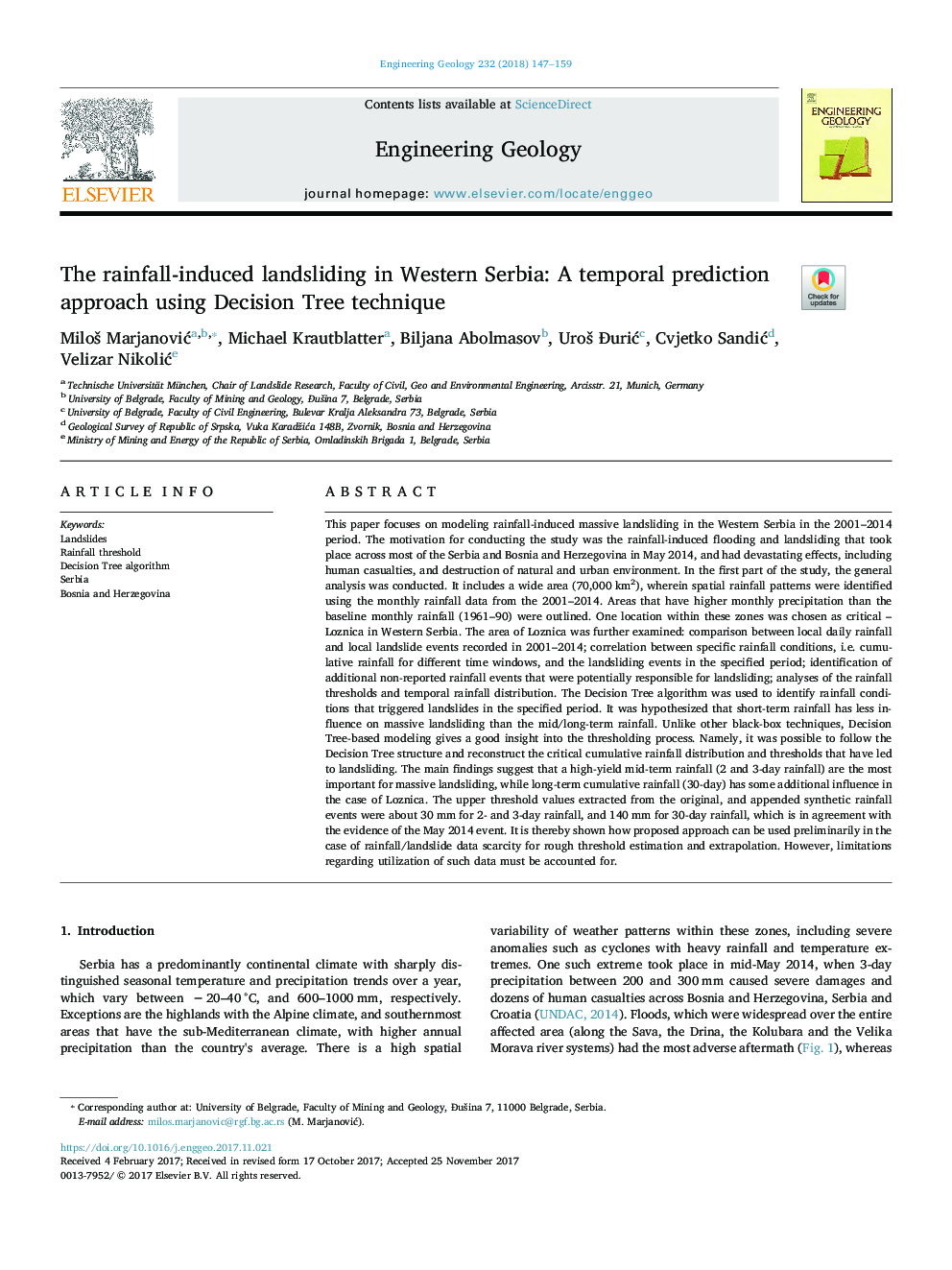| کد مقاله | کد نشریه | سال انتشار | مقاله انگلیسی | نسخه تمام متن |
|---|---|---|---|---|
| 8916008 | 1641753 | 2018 | 13 صفحه PDF | دانلود رایگان |
عنوان انگلیسی مقاله ISI
The rainfall-induced landsliding in Western Serbia: A temporal prediction approach using Decision Tree technique
ترجمه فارسی عنوان
زمین لرزه ناشی از بارندگی در غرب صربستان: یک روش پیش بینی زمانی با استفاده از تکنیک تصمیم گیری درخت
دانلود مقاله + سفارش ترجمه
دانلود مقاله ISI انگلیسی
رایگان برای ایرانیان
کلمات کلیدی
زمین لغزش، آستانه بارش، الگوریتم درخت تصمیم گیری، صربستان، بوسنی و هرزگوین،
موضوعات مرتبط
مهندسی و علوم پایه
علوم زمین و سیارات
مهندسی ژئوتکنیک و زمین شناسی مهندسی
چکیده انگلیسی
This paper focuses on modeling rainfall-induced massive landsliding in the Western Serbia in the 2001-2014 period. The motivation for conducting the study was the rainfall-induced flooding and landsliding that took place across most of the Serbia and Bosnia and Herzegovina in May 2014, and had devastating effects, including human casualties, and destruction of natural and urban environment. In the first part of the study, the general analysis was conducted. It includes a wide area (70,000Â km2), wherein spatial rainfall patterns were identified using the monthly rainfall data from the 2001-2014. Areas that have higher monthly precipitation than the baseline monthly rainfall (1961-90) were outlined. One location within these zones was chosen as critical - Loznica in Western Serbia. The area of Loznica was further examined: comparison between local daily rainfall and local landslide events recorded in 2001-2014; correlation between specific rainfall conditions, i.e. cumulative rainfall for different time windows, and the landsliding events in the specified period; identification of additional non-reported rainfall events that were potentially responsible for landsliding; analyses of the rainfall thresholds and temporal rainfall distribution. The Decision Tree algorithm was used to identify rainfall conditions that triggered landslides in the specified period. It was hypothesized that short-term rainfall has less influence on massive landsliding than the mid/long-term rainfall. Unlike other black-box techniques, Decision Tree-based modeling gives a good insight into the thresholding process. Namely, it was possible to follow the Decision Tree structure and reconstruct the critical cumulative rainfall distribution and thresholds that have led to landsliding. The main findings suggest that a high-yield mid-term rainfall (2 and 3-day rainfall) are the most important for massive landsliding, while long-term cumulative rainfall (30-day) has some additional influence in the case of Loznica. The upper threshold values extracted from the original, and appended synthetic rainfall events were about 30Â mm for 2- and 3-day rainfall, and 140Â mm for 30-day rainfall, which is in agreement with the evidence of the May 2014 event. It is thereby shown how proposed approach can be used preliminarily in the case of rainfall/landslide data scarcity for rough threshold estimation and extrapolation. However, limitations regarding utilization of such data must be accounted for.
ناشر
Database: Elsevier - ScienceDirect (ساینس دایرکت)
Journal: Engineering Geology - Volume 232, 8 January 2018, Pages 147-159
Journal: Engineering Geology - Volume 232, 8 January 2018, Pages 147-159
نویسندگان
MiloÅ¡ MarjanoviÄ, Michael Krautblatter, Biljana Abolmasov, UroÅ¡ ÄuriÄ, Cvjetko SandiÄ, Velizar NikoliÄ,
